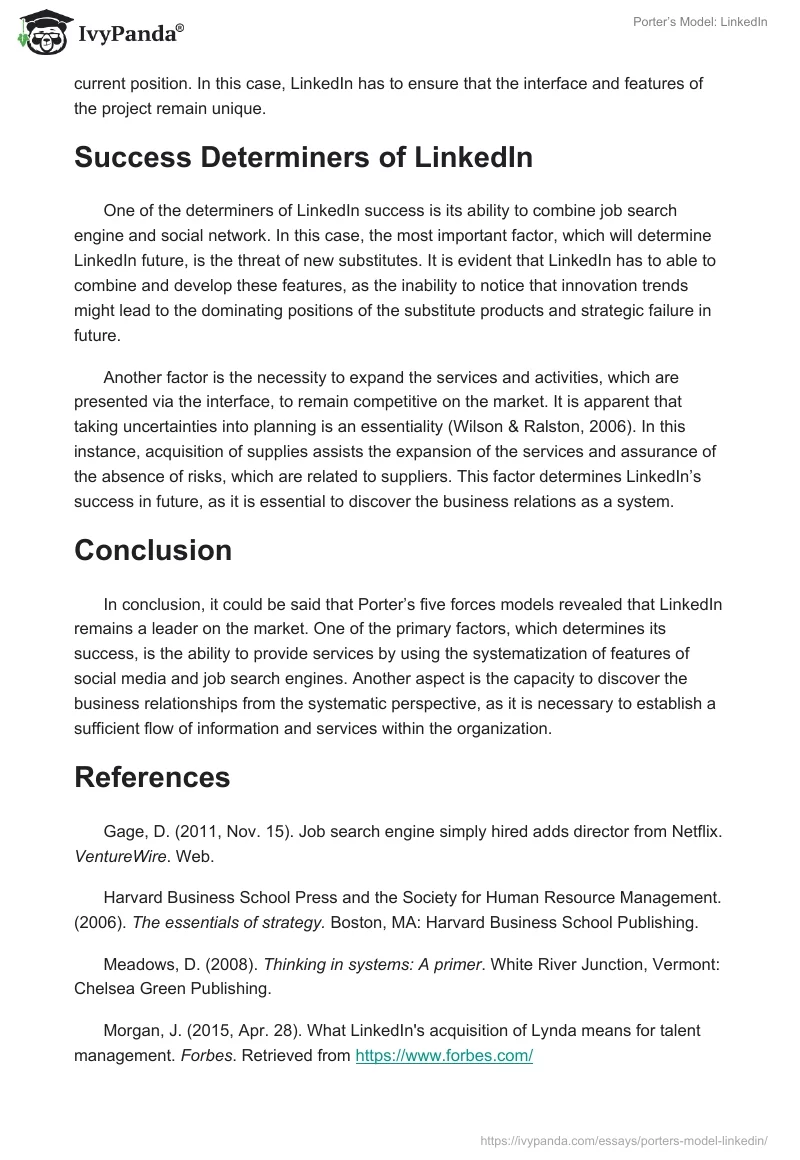Porter’s five forces is a marketing analytical tool, which helps determine a current position of the company on the market (Harvard Business School Press, 2006).
Moreover, any company should consider the world from the systematic perspective, as there is a vehement interdependence between all contributors (Meadows, 2008). A primary goal of this case study is to analyze LinkedIn’s position on the market by using Porter’s model. Furthermore, two fundamental aspects, which determine company’s success, are analyzed. In the end, the conclusions are drawn.
Porter’s Five Forces Analysis
Firstly, Porter’s five forces analysis is conducted. It could be said that the bargaining power of suppliers is low, as there is a significant number of possibilities to switch to in instance of necessity. Nonetheless, LinkedIn has a tendency to purchase its suppliers such as Lynda to ensure its positions on the market and broaden its area of operations (Morgan, 2015).
As for the bargaining power of customers, it remains insignificant to moderate as the individual users, organizations, and companies represent the customers. The primary income is collected from the businesses. In this case, it is apparent that LinkedIn provides unique services and can control the prices effectively.
A threat of substitute products is moderate, as LinkedIn plays the role of the job provider, and many companies with the similar services are present on the market. One of the job search engines examples is Simply Hired Inc., which allows users to view the tendencies of the labor market (Gage, 2010). In turn, a threat of new entrants is moderate, as it is apparent that the exit barriers remain insignificant, and companies such as Facebook and Twitter can quickly add job search engines to their interface.
Finally, the competitive rivalry is moderate. Despite having the moderate entrance barriers and increasing competition in this sector, LinkedIn remains the leader in this field, as it can combine a job search engine and social network. Nonetheless, other companies have a tendency to develop rapidly, and it might lead to the loss of its current position. In this case, LinkedIn has to ensure that the interface and features of the project remain unique.
Success Determiners of LinkedIn
One of the determiners of LinkedIn success is its ability to combine job search engine and social network. In this case, the most important factor, which will determine LinkedIn future, is the threat of new substitutes. It is evident that LinkedIn has to able to combine and develop these features, as the inability to notice that innovation trends might lead to the dominating positions of the substitute products and strategic failure in future.
Another factor is the necessity to expand the services and activities, which are presented via the interface, to remain competitive on the market. It is apparent that taking uncertainties into planning is an essentiality (Wilson & Ralston, 2006). In this instance, acquisition of supplies assists the expansion of the services and assurance of the absence of risks, which are related to suppliers. This factor determines LinkedIn’s success in future, as it is essential to discover the business relations as a system.
Conclusion
In conclusion, it could be said that Porter’s five forces models revealed that LinkedIn remains a leader on the market. One of the primary factors, which determines its success, is the ability to provide services by using the systematization of features of social media and job search engines. Another aspect is the capacity to discover the business relationships from the systematic perspective, as it is necessary to establish a sufficient flow of information and services within the organization.
References
Gage, D. (2011, Nov. 15). Job search engine simply hired adds director from Netflix. VentureWire. Web.
Harvard Business School Press and the Society for Human Resource Management. (2006). The essentials of strategy. Boston, MA: Harvard Business School Publishing.
Meadows, D. (2008). Thinking in systems: A primer. White River Junction, Vermont: Chelsea Green Publishing.
Morgan, J. (2015, Apr. 28). What LinkedIn’s acquisition of Lynda means for talent management. Forbes. Retrieved from https://www.forbes.com/
Wilson, I., & Ralston, W. (2006). The scenario planning handbook. Mason, Ohio: Thomson/South-Western.


